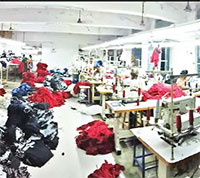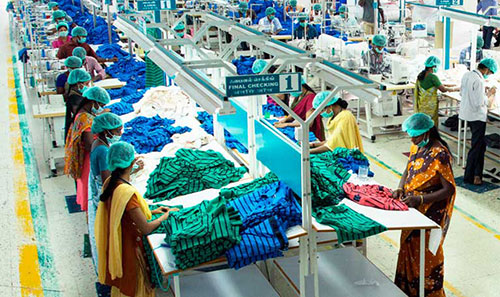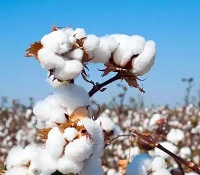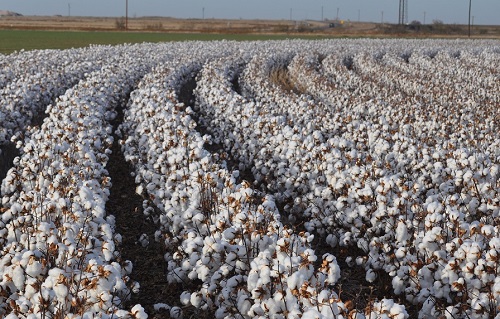FW
 Around 5000 selected professional visitors, including 80% of decision makers – from 45 countries, are expected to attend the Interfiliere Shanghai 2020 show to be held in China which focuses on the lingerie industry. These include senior buyers, head of purchasing, head of design, product managers, export managers, sales & marketing managers, CEOs and managing directors.
Around 5000 selected professional visitors, including 80% of decision makers – from 45 countries, are expected to attend the Interfiliere Shanghai 2020 show to be held in China which focuses on the lingerie industry. These include senior buyers, head of purchasing, head of design, product managers, export managers, sales & marketing managers, CEOs and managing directors.
"The newly rebranded Intertextile Shenzhen Apparel Fabrics (formerly Intertextile Pavilion Shenzhen) will take place from July 15 to 17, at a brand new venue – the Shenzhen World Exhibition and Convention Center. Over 2,000 exhibitors are expected to join in a space spread over 60,000 sq. mt (2019: 1,065 exhibitors). Held concurrently with the first Shenzhen edition of Yarn Expo, as well as CHIC and PH Value, the fair offers a comprehensive, convenient platform for sourcing between seasons in South China."
 The newly rebranded Intertextile Shenzhen Apparel Fabrics (formerly Intertextile Pavilion Shenzhen) will take place from July 15 to 17, at a brand new venue – the Shenzhen World Exhibition and Convention Center. Over 2,000 exhibitors are expected to join in a space spread over 60,000 sq. mt (2019: 1,065 exhibitors). Held concurrently with the first Shenzhen edition of Yarn Expo, as well as CHIC and PH Value, the fair offers a comprehensive, convenient platform for sourcing between seasons in South China.
The newly rebranded Intertextile Shenzhen Apparel Fabrics (formerly Intertextile Pavilion Shenzhen) will take place from July 15 to 17, at a brand new venue – the Shenzhen World Exhibition and Convention Center. Over 2,000 exhibitors are expected to join in a space spread over 60,000 sq. mt (2019: 1,065 exhibitors). Held concurrently with the first Shenzhen edition of Yarn Expo, as well as CHIC and PH Value, the fair offers a comprehensive, convenient platform for sourcing between seasons in South China.
Wendy Wen, Senior General Manager of Messe Frankfurt (HK) says, “Intertextile Shenzhen has long offered an access point to key garment manufacturers, from South China to Southeast Asia and beyond. The move to a new venue means the fair has room to grow even more, in a convenient location. And following the successful model of Intertextile Shanghai with three concurrent fairs, the July date makes this the ideal fair for trade buyers who need a one-stop shop for apparel sourcing between seasons.”
Shenzhen, world’s garment production centre
Shenzhen is a key city in China’s Greater Bay Area, a central government scheme to develop an integrated economic hub by linking nine major cities of South China’s Guangdong Province, Hong Kong and Macau. The Greater Bay Area includes major garment manufacturing hubs for all kinds of garment clusters, including ladieswear, menswear, kids wear, denim, wool and underwear.
economic hub by linking nine major cities of South China’s Guangdong Province, Hong Kong and Macau. The Greater Bay Area includes major garment manufacturing hubs for all kinds of garment clusters, including ladieswear, menswear, kids wear, denim, wool and underwear.
The new venue is located near the Shenzhen Bao’an International Airport, while the area is also well connected via high speed trains and the world’s third largest ferry port, ensuring convenience for local manufacturers as well as international buying offices from Hong Kong. The fair is also an ideal location for garment producers from countries in the ASEAN region, such as Vietnam, Thailand, Indonesia, the Philippines, Malaysia and Cambodia.
A world-class fashion destination
The venue is close to Dalang Fashion Town in Shenzhen, an ongoing development subsidised by the government that aims to use the momentum of the Greater Bay Area to build an international fashion centre. The development builds on top of Shenzhen’s strong foundations in fashion, with the city already being a well-known ladieswear hub, home to around 30,000 fashion designers and over 2,000 fashion retailers.
Aiming to specialise in technology, design and sustainability, Dalang Fashion Town is part of China’s efforts to continue to expand its textile industry from not only manufacturing, but also to design and trendsetting. The area is home to around 500 domestic fashion enterprises.
Fair meets year-round demand of the fashion industry
Fast fashion and sustainability rarely meet in the middle however, both concepts are key drivers towards smaller batch sizes and on-demand replenishment. Market needs now constantly adapt to fast fashion trends outside of traditional Spring and Autumn collections, while at the other end of the spectrum, demand for sustainability is predicted to continue to grow in the 2020s, as public awareness of overproduction issues in the fashion industry rises.
Intertextile Shenzhen’s mid-summer date makes it an ideal event for trade buyers to replenish stocks between seasons, while many exhibitors also offer product-in-stock services for faster processing. Smaller batch orders are also welcomed by many exhibitors at the fair, encouraging the industry to reduce waste through over-production.
Intertextile Shenzhen Apparel Fabrics will be held from July 15to 17, 2020. The organizers are: Messe Frankfurt (HK) Ltd; the Sub-Council of Textile Industry (CCPIT) and the China Textile Information Centre.
 Jersey Lomellina is launching ‘Hole in one’, a new advertising campaign dedicated to the world of performance fabrics for sportswear. Customers will then be planning various versions of the campaign worldwide.
Jersey Lomellina is launching ‘Hole in one’, a new advertising campaign dedicated to the world of performance fabrics for sportswear. Customers will then be planning various versions of the campaign worldwide.
The campaign by Jersey Lomellina, and international leader in the production of stretch circular knitted fabrics and consolidated symbol of 100 per cent Made in Italy quality in the world, is dedicated to golf. It is a milestone for the company which, for the first time in its history, moves from women’s wear to a more high performance, dynamic, high-tech, modern and elegant menswear.
For the first time ever Jersey Lomellina has collaborated with an illustrator to bring the campaign to life: Jacopo Camagni, an artist whose style hints at the American and European school but with some Japanese influences, has introduced some elements of the Manga world to get closer to the Far East in the campaign. A new hybrid image was born, an innovative and unique crossover.
Lomellina has chosen the world of comics also because it is in line with the recent eco-friendly trend: in addition to allowing countless creative possibilities, illustration does not need people to move and does not require the use of high environmental impact instruments like photo shooting sets.
Euratex welcomes the proposed new EU industrial strategy but wonders how the proposed principles will be put into practice; reality checks and close monitoring of the implementation of the strategy will be essential to make a positive and sustainable impact.
The European textiles and apparel industry, worth nearly €180 bln and including 171,000 companies, is an essential pillar of the European industry. It is a very globalised industry with extensive value chains across different continents. Over the last 10 years, real changes have been made to innovate and increase sustainability of its products, starting from traditional clothing to smart and medical textiles, industrial applications in the automotive and aerospace industry, to protective wear and high-end fashion.
Against this background, Euratex welcomes the launch of a new comprehensive EU industrial strategy. It is high time for Europe to embrace its industry again, as a source of welfare, innovation and employment. The proposed strategy is rightfully putting emphasis on economic sovereignty, without falling into the trap of protectionism.
The strategy should include some important elements, essential for its success:
• Any proposed measure must be assessed in a global context, i.e. European companies cannot be subject to new rules, standards or regulations unless all players do play with the same rules. Measures to ensure a level playing field must be realistic and effective.
• Innovation into a more sustainable industry has an important cost, and the end consumer is not always willing to pick up that cost. This may jeopardize the financial sustainability of our industry, especially for smaller companies. Accompanying measures should be taken to alleviate the burden of green investments, especially for SMEs.
• Labour force shortage is an important barrier to the development of our industry. In 2018, 34% of the Textile and Clothing workforce was over the age of 50 (a steep increase from the 22% just 10 years ago). It is therefore urgent to make a common effort to both upskill and reskill the current workforce and to attract young talent.
While the principles mentioned in the strategy are sound, effective implementation of such principles into practical measures will be critical. Too often in the past, the EU has presented ambitious plans, but failed to deliver on their implementation, either by lack of resources or political will from member states. Euratex therefore calls for a strict “governance” of this new strategy, introducing measurable targets, which can be monitored by relevant stakeholders. “We should be vigilant that proposed measures are realistic and effective, and actually support industrial competitiveness, rather than adding a regulatory or financial burden”, commented Director General Dirk Vantyghem on the proposed strategy.
Euratex stands ready to contribute to a positive and effective implementation of the strategy, making sure the European economy can regain its competitiveness, create jobs and welfare.
As the voice of the European textile and clothing industry, Euratex works to achieve a favourable environment within the European Union for design, development, manufacture and marketing of textile and clothing products.
The EU textile and clothing industry, with over € 50 billion of exports, is a global player successfully commercializing high added value products on growing markets around the world.
Working together with EU institutions and other European and international stakeholders, Euratex focuses on clear priorities: an ambitious industrial policy, effective research, innovation and skills development, free and fair trade, and sustainable supply chains.
Stephan Trubrich assumed the new role as Vice President Capital Markets, effective as at March 01, 2020. In his capacity, Trubrich will oversee the Lenzing Group’s capital markets activities, including Investor Relations and ESG (Environmental, Social & Governance) Reporting. He will report directly to Stefan Doboczky, Chief Executive Officer of the Lenzing Group. Stephan Trubrich has more than 9 years of experience in the field of equity research with Kepler Cheuvreux, UniCredit and Deutsche Bank. For many years, he has been Austria’s top ranked equity analyst. Trubrich holds a Master’s Degree in Science in Accounting and Finance from Aston Business School, UK. He is also a CFA Charterholder. Stephanie Kniep, Head of Investor Relations, will leave Lenzing, effective as of April 30, 2020 to pursue new endeavors.
"As the retail sector evolves, the line between online and offline shopping is getting blurred. Innovations in the sector are making it easier for customers to choose their preferred products while shopping. To compete with this new reality, brands need to build a trustful relationship of with customers. “They need to ensure that each customer, who walks into the store, gets the best experience of his life,” says a spokesperson for Mumbai’s Korum Mall."
 As the retail sector evolves, the line between online and offline shopping is getting blurred. Innovations in the sector are making it easier for customers to choose their preferred products while shopping. To compete with this new reality, brands need to build a trustful relationship of with customers. “They need to ensure that each customer, who walks into the store, gets the best experience of his life,” says a spokesperson for Mumbai’s Korum Mall.
As the retail sector evolves, the line between online and offline shopping is getting blurred. Innovations in the sector are making it easier for customers to choose their preferred products while shopping. To compete with this new reality, brands need to build a trustful relationship of with customers. “They need to ensure that each customer, who walks into the store, gets the best experience of his life,” says a spokesperson for Mumbai’s Korum Mall.
To reach out to a maximum number of customers, many e-commerce brands are opening pop-up stores across the country. “Driven by the agility and efficiency, these digitally native brands aim to provide great consumer experience through automated logistics,” he explains.
Sustainable measures and eco-friendly production will enable brands to more engage with existing customers. It will also allow them to create new customers. “There is an alarming need to take care of our planet.” For this, he advises brands to adopt measures like avoiding plastic, using non-polluting materials, regenerating and applying new technologies. “Customers are appreciating companies that are shifting to more sustainable practices,” he adds.
will also allow them to create new customers. “There is an alarming need to take care of our planet.” For this, he advises brands to adopt measures like avoiding plastic, using non-polluting materials, regenerating and applying new technologies. “Customers are appreciating companies that are shifting to more sustainable practices,” he adds.
Experiential retailing, personalise attention to create a niche
It is also important for a brand to hold customers attention through story-telling and providing them with a great experience. “Speeding of experimental retail is creating memorable experiences for the customer. Malls are infusing entertainment options into their mix in order to transform their retail environment,” he adds.
Brands are also rewarding customer loyalty by offering them new options for subscriptions or membership benefits for their favourite media like Netflix, Amazon, Hotstar,etc. “This has helped them grow 100 per cent per cent in the last five years,” notes the spokesperson. Though this is a result of a steady stream of venture capital investments, subscription e-commerce is also responsible for its growth as it provides personalised, easiest and affordable ways to satisfy a customer’s need.
Shift from online to offline
Both online and offline operations are important for catering to the needs of the customers. However, these days many online players are expanding their presence in the physical realm by opening stores. “A testament of this trend is the online stores of Amazon books and Amazon go which have transformed from online to pop-stores.” Other digitally native retailers also plan to open physical stores in near future.
3D design tools to reduce time and costs
Store designs are also gaining prominence these days as companies are adopting 3D tools to reduce the cost and time involved in sampling and fitting and improving margins. “Investing in these 3D virtual tools helps us to effectively plan our store’s design, layout and determining product positioning,” adds the spokesperson.
Tracking customer demands
It is important for brands to know their customers choices and preferences if they want to retain him for a long term. There are many new software’s available today that help brands track their customers’ data. However, these software have certain limitations. Hence, brands need to be a better observant of trends.
Consumers no longer focus on not just filling their closet with new purchases. They are now able to differentiate between meaningful and not so meaningful purchases. “The current year is likely to bring more challenges for retailers as they will have to frame their retail experiences around the human component and view each person who visits their stores as a golden opportunity,” he sums up
 Accounting for almost 46 per cent of India’s garment exports, Tiruppur knitwear hub has been under acute stress since for the last few years due to the twin blows of demonetisation and GST.
Accounting for almost 46 per cent of India’s garment exports, Tiruppur knitwear hub has been under acute stress since for the last few years due to the twin blows of demonetisation and GST.
Cheaper products, duty-free access attract buyers to competing countries
The multi-crore industry in the cluster is on the verge of a breakdown and the only savior seems to be remedial measures that the government plans to announce to save the city’s knitwear sector from all the external and internal challenges that it faces. Tamil Nadu exporters say India is losing out to Bangladesh, Sri Lanka, Cambodia even Ethiopia as these nations offer free access to key markets like the EU and US. Moreover, their products are cheaper and they offer cost-effective labor and free access to key markets. Buyers also do not have to pay an additional 10 percent duty on imports from these countries as is the case with India.
Another factor troubling Indian exporters is the government’s decision to withdraw the 4 per cent merchandise exports from India scheme (MEIS) incentive retrospectively from March 2019. They feel, this will result in massive losses, running into several multi millions.
exports from India scheme (MEIS) incentive retrospectively from March 2019. They feel, this will result in massive losses, running into several multi millions.
Slump in orders leads to production scale down
A slump in orders has forced several manufacturers to scale down operations. For instance, orders for leading exporter Santex Inc’s India unit declined by almost half though they have grown exponentially in their Sri Lankan unit. Orders from Sri Lanka, Myanmar, Cambodia and Vietnam have increased as buyers prefer these countries for their low-cost products.
As Raja M Shanmugham, President of the Tiruppur Exporters’ Association (TEA) point out, despite being the largest producer of cotton and having a huge workforce, India is losing out to Bangladesh in the apparel sector. The situation is likely to worsen, as an FTA between EU and Vietnam operationalised a fortnight ago, would compel Tiruppur manufacturers to compete with Vietnam as well.
MEIS withdrawal to result in Rs 1,000 crore loss
Dealing another blow to Tiruppur manufacturers, the Indian government recently decided to withdraw the MEIS scheme granted to exporters. This is likely to result in a loss of around Rs 1,000 crore for these exporters who survive on thin margins.
These manufacturers are also plagued by a few other problems like their high production costs and labor shortages. Their production costs are almost 15-20 per cent more than those of Bangladesh manufacturers. Also, labor wages have doubled over the last few years. As a result, Indian exporters have been able to clock in just $17 billion in the past five years, while Bangladesh has clocked in around $38 billion exports in the same period.
 Having stabilised during most of February, international cotton prices collapsed during the end of the month and beginning of March as fears over the spread of Coronavirus (COVID-19) amplified during this period. The Cotlook A Index began the month on a modestly weak note as China markets returned from the Lunar New Year holiday with a steep downward turn. Though this index reached a high point of 78.30 US cents per lb, a renewed caution in the later part of the month further dampened spirits with several international events being postponed. This also affected business activities during the month as spinners did not commit themselves to large volume sales or purchases.
Having stabilised during most of February, international cotton prices collapsed during the end of the month and beginning of March as fears over the spread of Coronavirus (COVID-19) amplified during this period. The Cotlook A Index began the month on a modestly weak note as China markets returned from the Lunar New Year holiday with a steep downward turn. Though this index reached a high point of 78.30 US cents per lb, a renewed caution in the later part of the month further dampened spirits with several international events being postponed. This also affected business activities during the month as spinners did not commit themselves to large volume sales or purchases.
Despite many factories in China reopening, downstream sector remained sluggish impacting spinners’ orders and raising concerns over the potential of serious disruption to supply chains if the government failed to contain the virus in the next month or so.
Decline in prices boosts sales
However, a considerable decline in cotton prices during the last portion of February tempted buyers back to the market with a steep rise in demand from a broad range of countries. Two consecutive weekly marketing-year high sales figures in the first half of the month also improved the pace of shipments.
broad range of countries. Two consecutive weekly marketing-year high sales figures in the first half of the month also improved the pace of shipments.
Increase in government-inspired sales
On February 14, the ‘Phase One’ bilateral trade agreement came into force, a month after its ratification in Washington. The deal commits China to a substantial increase in purchases of US agricultural commodities, including cotton. Though the deal resulted in moderate new sales to China, it also led to a cancellation in few of the existing contracts. The deal is also likely to result in government-inspired purchases of US cotton being made by or on behalf of the country’s State Reserve.
In February, Cotlook published its tentative initial estimates of global production and consumption for the season ahead, in this case 2020/21. The starting point for its US production figure was the outlook for acreage as put forward by the National Cotton Council’s Planting Intentions survey. Its average yield and abandonment are anticipated in most states, meaning Cotlook’s second-largest crop of the last decade was worth more than 4.4 million tonne.
Coronavirus to impact consumption and production
Taking the above figures into account, Cotlook forecasts world production in 2020/21 to be just over 26 million tons, only marginally above the figure for the current season. Assessing the consumption outlook has been made more challenging this year by uncertainty regarding the duration of the Coronavirus outbreak and its impact on commercial and industrial activity not only in China but also in the rest of the world. For now, Chinese consumption can be estimated to recover to 8.3 million ton on the assumption that the disruption witnessed this season will have abated by the middle of this year.
Outside China, consumption will expand modestly in the Indian subcontinent and in certain Far Eastern countries. Global consumption in 2020/21 is likely to rise to 25.9 million ton. However, this optimism may prove misplaced if the worst fears regarding the economic impact of a global epidemic are realised.
In the first nine months of 2019, Vietnam’s exports to the US jumped by 34.8 per cent year on year. The United States is Vietnam’s largest export market. Overall, Vietnam-US trade will likely to continue to increase. However, Vietnam will need to be more careful particularly for industries such as steel, footwear and agricultural products exports to the US that have been growing. If it does not, the United States is likely to impose countervailing duties on products that it deems to harm its domestic industries. Vietnam however, will have to be even more careful to deal with origin fraud and transshipment as this has been the source of US tariffs on Vietnam in the past. The tariffs were imposed to prevent steel products that originated from China attempting to bypass anti-dumping rules. Vietnam subsequently issued new regulations related to the origin of exported and imported goods. Most recently, Vietnam addressed transshipment and origin fraud. The move was in line to satisfy US rules of origin requirements and address the trade surplus.
The US recently slimmed down its list of developing and least developed countries, thus removing Vietnam from receiving preferential trade benefits. The move, however, was not directed specifically at Vietnam but included several other countries.
Textile exports from many Indian states have reduced in the last five years. From New Delhi, textile exports halved from FY15 to FY19. Punjab and Andhra Pradesh saw a contraction of 20 per cent and 16 per cent respectively. Overall exports from the textile sector rose 2.2 per cent while overall textile imports shot up 13.1 per cent between FY15 and FY19. India’s top five textile export destinations are the US, Bangladesh, China, Pakistan, the UK, while the top five import destinations are China, the US, Australia, Bangladesh, and Taiwan. However, to curtail imports of textiles and to boost domestic production, India has doubled the basic customs duty from ten per cent to 20 per cent on 383 apparel HS lines.
The textile industry is a labor-intensive industry. So its growth plays a vital role in job creation. The textile industry is also one of the industries that have a major participation from the informal sector as well. Hence a fall in the industry causes a loss of jobs from the informal sector that is hardly measured.
India will help top textile companies achieve sufficient size and scale to cater to worldwide demand. The aim is to create a few global champions especially in the areas of manmade fiber, technical textiles, apparel, fabrics and made-ups because of the substantial value addition in these sectors.












